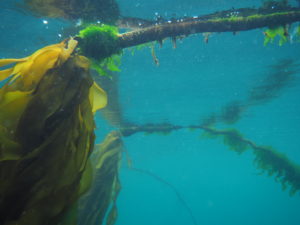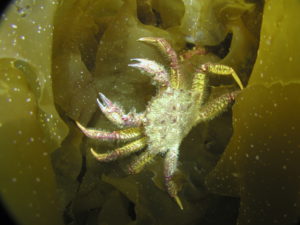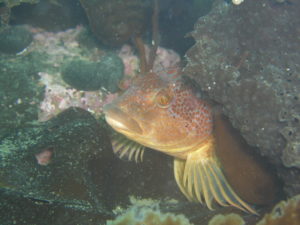Alaska never ceases to amaze me and the past few weeks on the Kenai Peninsula have been some of the best yet. The weather has been fantastic with sunny days and minimal wind. The salmon berries around the Kasitsna Bay Lab have been thriving and make for some very happy scientists that can grab a sweet treat with just a few steps. I have even had the chance to explore some of the incredible trails surrounding the laboratory and peppering the coastline of Kachemak Bay. The best part of hiking around Kachemak Bay is gaining a different perspective of the estuarine ecosystem. While the vast majority of the research I have helped with is on or in the water, the mountains and glaciers play a vital role in watershed and estuary dynamics, which connect to the big blue ocean.

The view of Tutka and Jakalof Bays while hiking Grace Ridge, which runs between them.

Happy hikers!
After 10 weeks, I am still in awe with the beauty of Alaska and that I get to be a part of research in such a diverse and productive ecosystem. One of the unique factors of research in Alaska is the high latitude. This makes Alaska a prime candidate for data contribution to studies along latitudinal gradients in order to measure how certain ecosystem functions vary, remain consistent, or are changing with latitude. One of these studies is the Kelp Ecosystem Ecology Network (KEEN) project lead by Jarrett Byrnes of University of Massachusetts, Amherst. At the start of my internship, there was talk of including KEEN in our array of projects this summer. I was especially excited because I was being trusted with going over protocol to make dive plans and creating a species list and guide for Alaska. I was anxious for the day that the good news would come of a window in our busy schedule to complete the KEEN sampling. Lucky for me, this day finally came on July 29th.
Studying kelp forests along a latitudinal gradient is an important component of assessing the health of kelp forest ecosystems in response to climate change. Kelp play a vital role in forming habitat for invertebrates and shelter for juvenile and adult fish. In order to assess the health of our kelp forests in Kachemak Bay, we conducted our first year of dive surveys to add to the KEEN global dataset. While Brenda Konar and her group consistently monitor kelp forests in Kachemak Bay, KEEN offers a unique approach for holistic sampling of each site and comparison to global kelp forests with an emphasis on public data access and sharing.
The KEEN protocol consists of four transects at each site. On each transect, we performed a fish swath, a target species swath, point counts, and quadrat surveys in order to document the kelp forest community structure and health at different levels of detail. For example, target species swaths are useful for documenting the number of Nereocystis (Bull Kelp) individuals exist along a transect, while quadrats are useful for counting the number of invertebrates in a square meter area. The fish swath diver records the number of each fish species that pass by while swimming the length of the transect, and the point count diver records the species directly under each side of a meter stick laid perpendicular to the transect tape at every meter.

En route to the KEEN site!
Brenda Konar, Katie McCabe, Tibor Dorsaz, and I surveyed Outside Beach, a kelp forest site located just outside of Seldovia Bay, home of the Village of Seldovia. Nereocystis can be seen as a bed on the surface, with fronds buoyed by a round gas-filled bulb. Beneath the surface, Saccharina (Sugar Kelp), mats the bed rock and makes a home for mobile and sessile invertebrates of vast colors and geometries.

Nereocystis studding the surface at Outside Beach KEEN site.

Nereocystis fronds are supported by a gas-filled bulb that floats at the surface. Photo by Brenda Konar.

Saccharina densely covers the bed rock, peppered with Nereocystis stipes. Photo by Brenda Konar.
Each transect takes one dive to complete and each of the four divers took on one component of the protocol. Since there are four transect, I had the chance to help with all four survey types. This was an interesting opportunity to view the same site from a different lens on each dive. Fish swaths are a brief pass of the transect looking above the ground cover for fish swimming by, while a quadrat will have you engulfed in kelp and entering a whole different world of chitons, gastropods, bivalves, echinoderms, and more

A crab finding shelter (and probably food) within kelp blades. Photo by Brenda Konar.

A greenling hiding between rocks and Agarum (Sieve Kelp). Photo by Brenda Konar.

Green Sea Urchin. Photo by Brenda Konar.

Small algal species, like this Opuntiella, are revealed after moving kelp fronds aside during detailed quadrat surveying. Photo by Brenda Konar.
It was equally as exciting as rewarding to dive in this beautiful kelp forest to contribute to the KEEN project. After soaking up the sun between four dives, a lot of underwater paper, and some peanut butter and jelly sandwiches, we successfully completed all four transects at Outside Beach. My next steps moving forward with KEEN are entering the data into the KEEN database. My first week in Alaska, I created a species list and field guide, including the species codes that the data are entered using. This way, anyone interested in viewing or using the data we collected will have an understanding of what codes refer to and what each species looks like through photos and species descriptions. It is a great feeling to be a part of a large, collaborative project. The addition of data from Alaska to this project was very desirable to establish a latitudinal gradient, and I am humbled to have been a part of contributing the first data set. Shortly, our data will be accessible through the KEEN website for viewing and use (www.kelpecosystems.org and Kelp Ecosystem Ecology Network Github). I’m very excited to have been a part of monitoring kelp forest health in order to preserve these incredibly important and beautiful ecosystems that are vulnerable to impacts of climate change. It is a global effort to monitor and manage these effects and projects like KEEN are harnessing the abilities of collaborators and citizen scientists worldwide.

